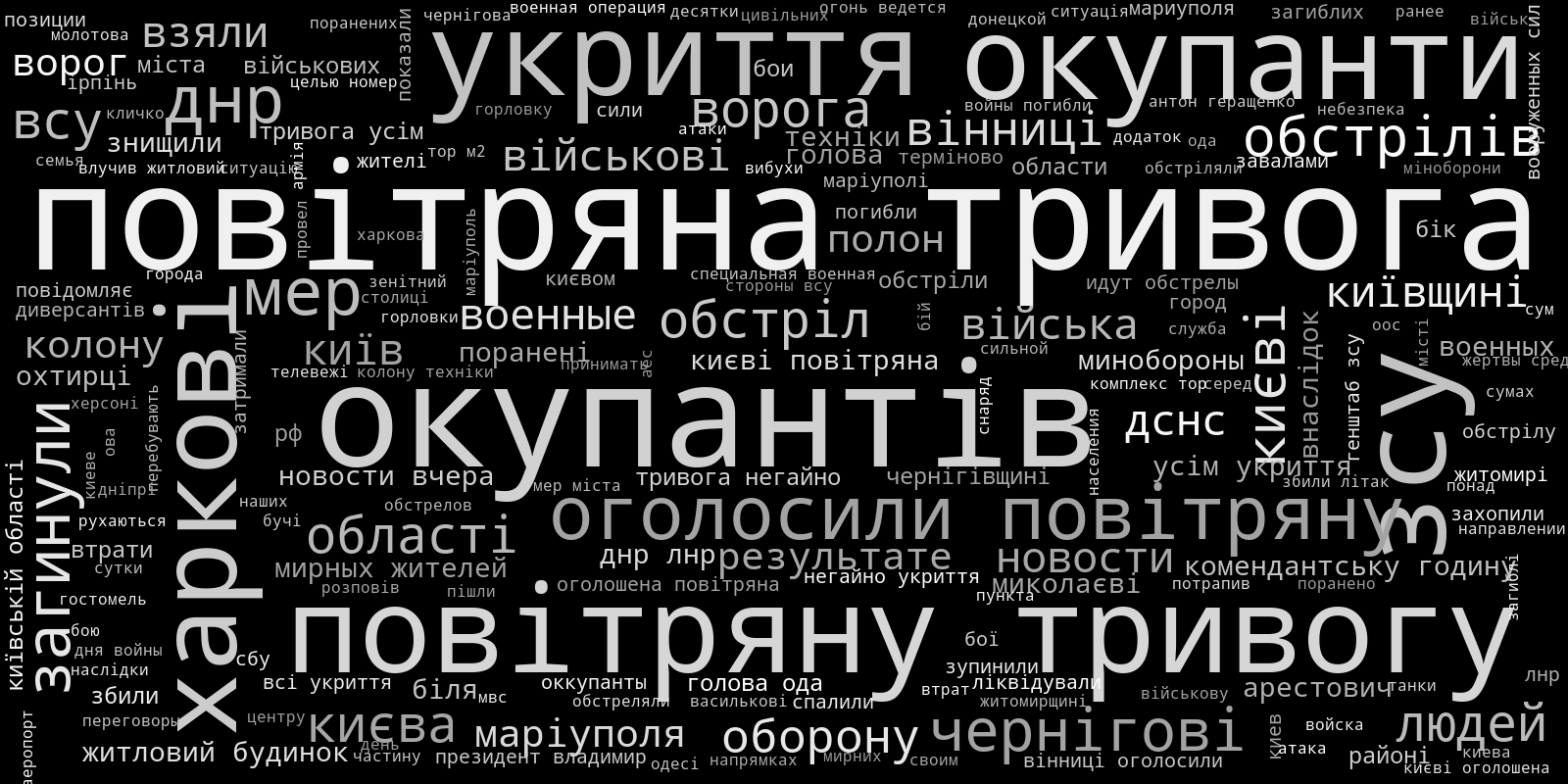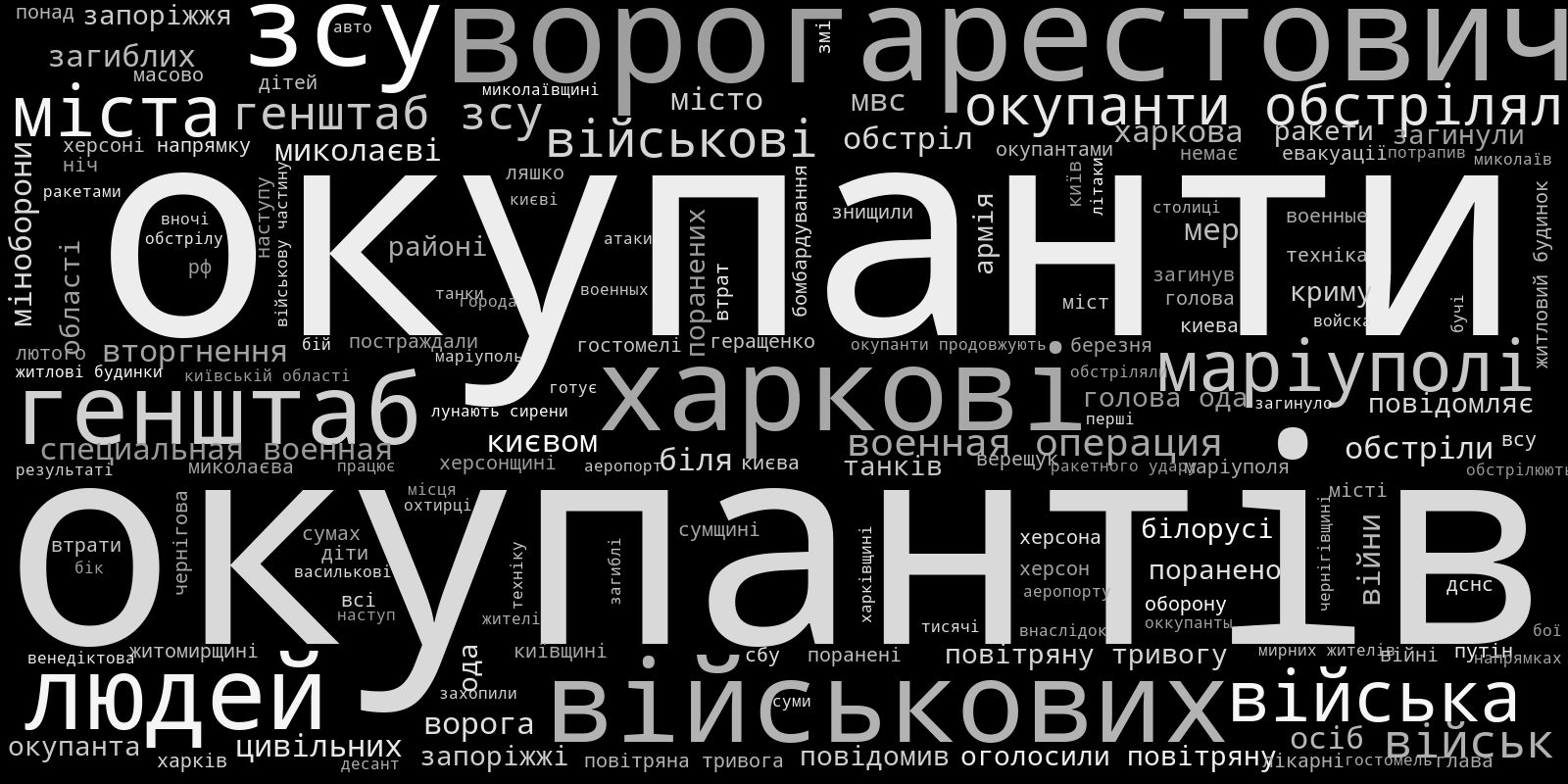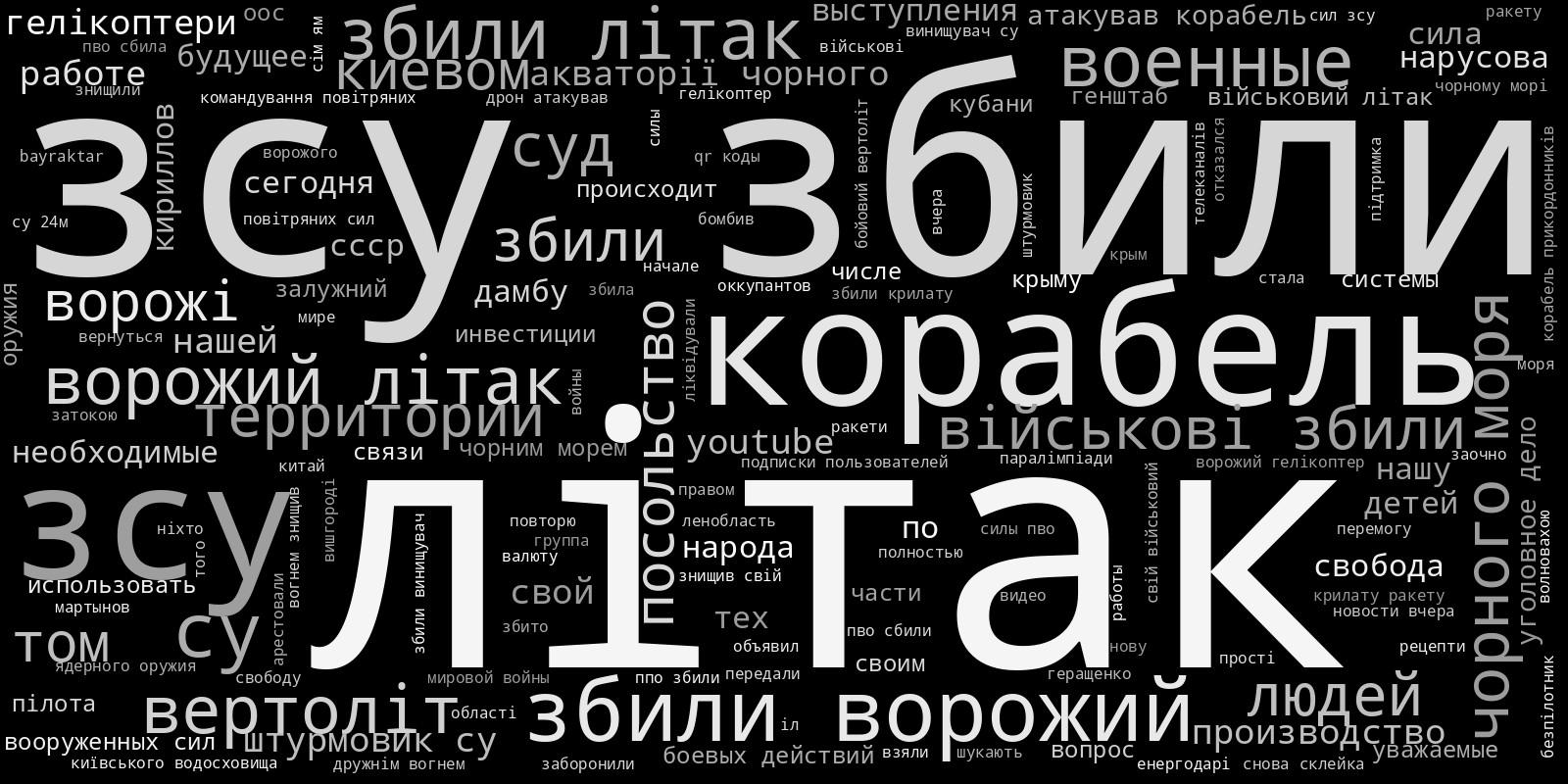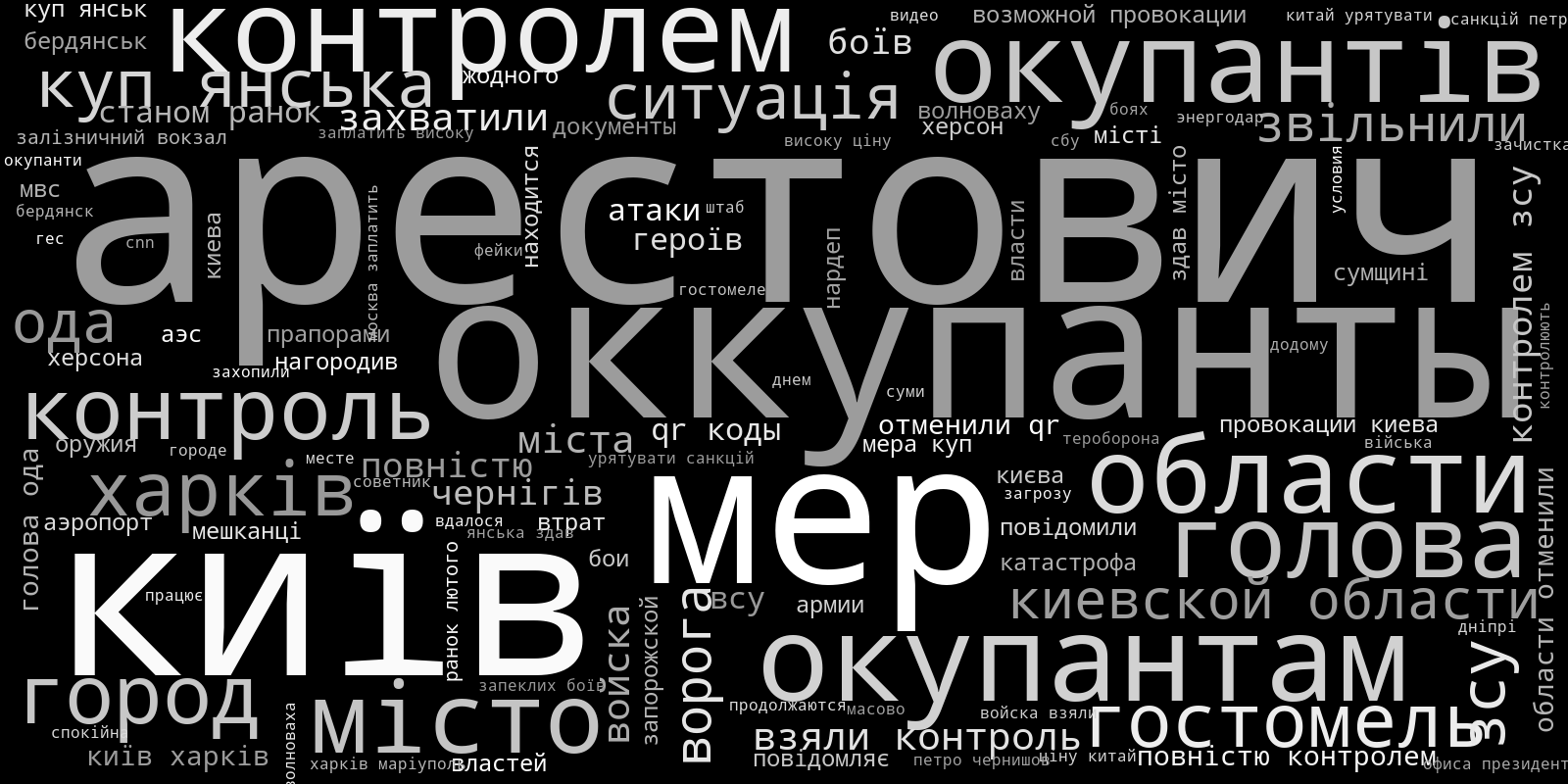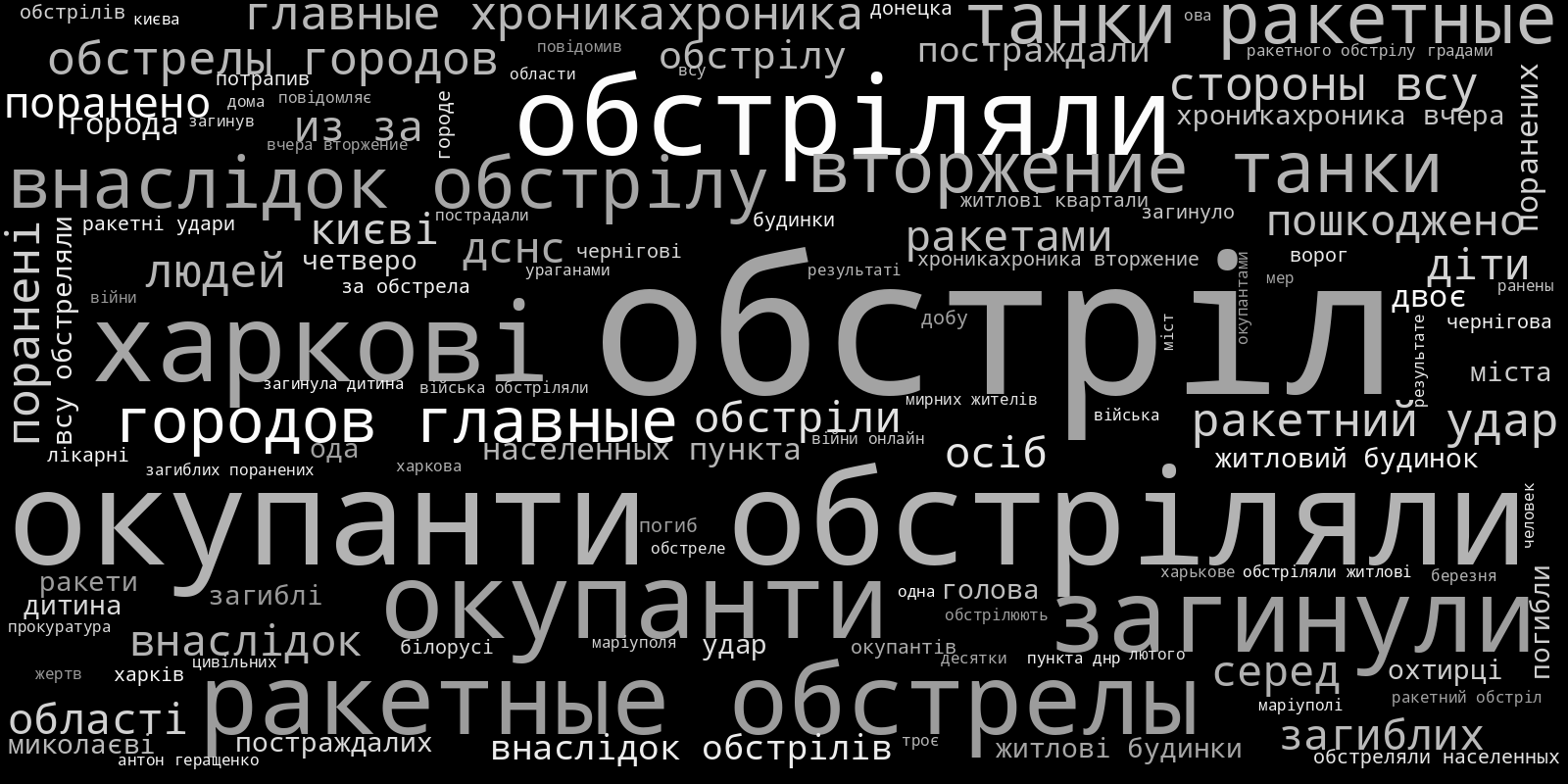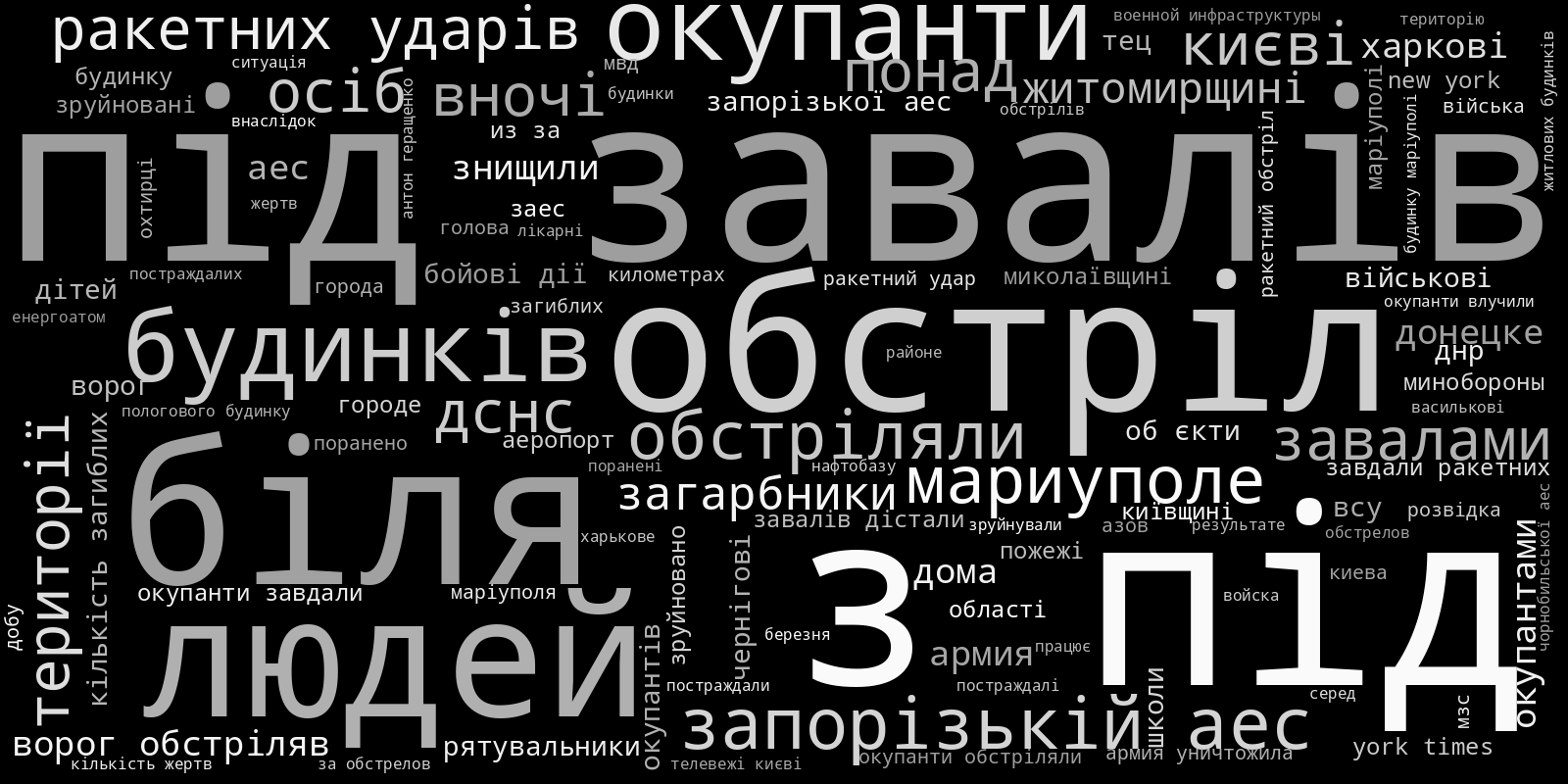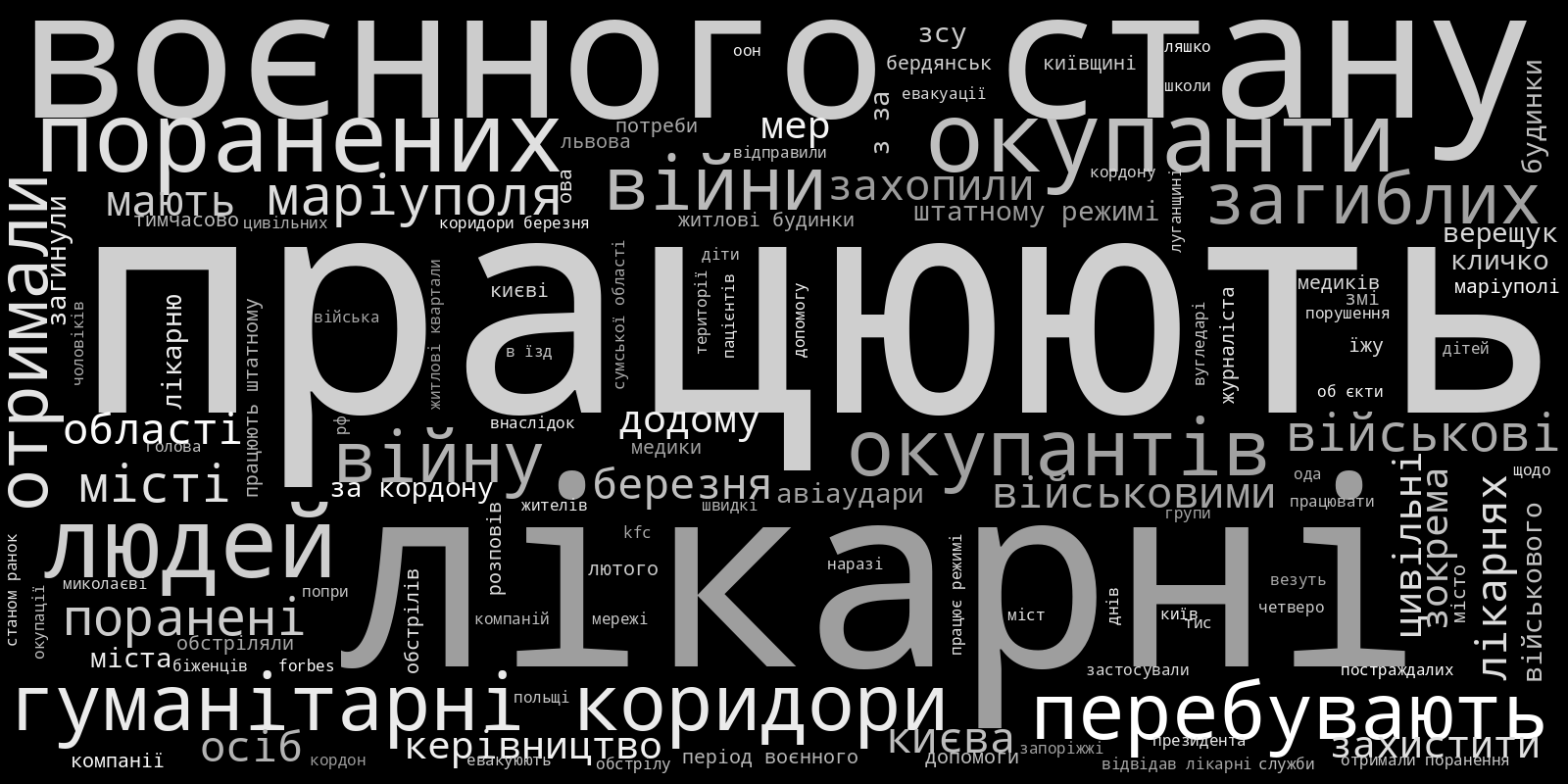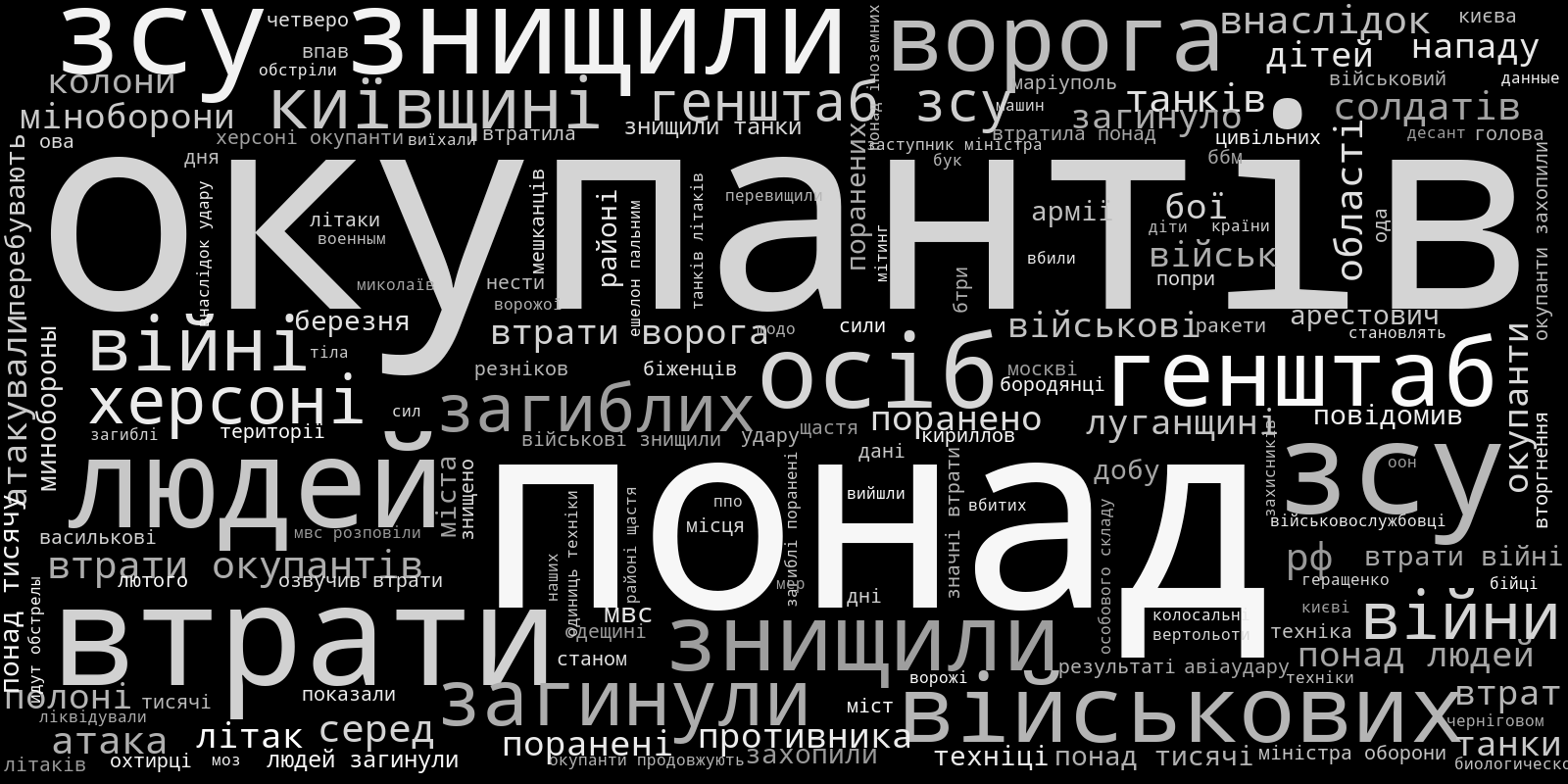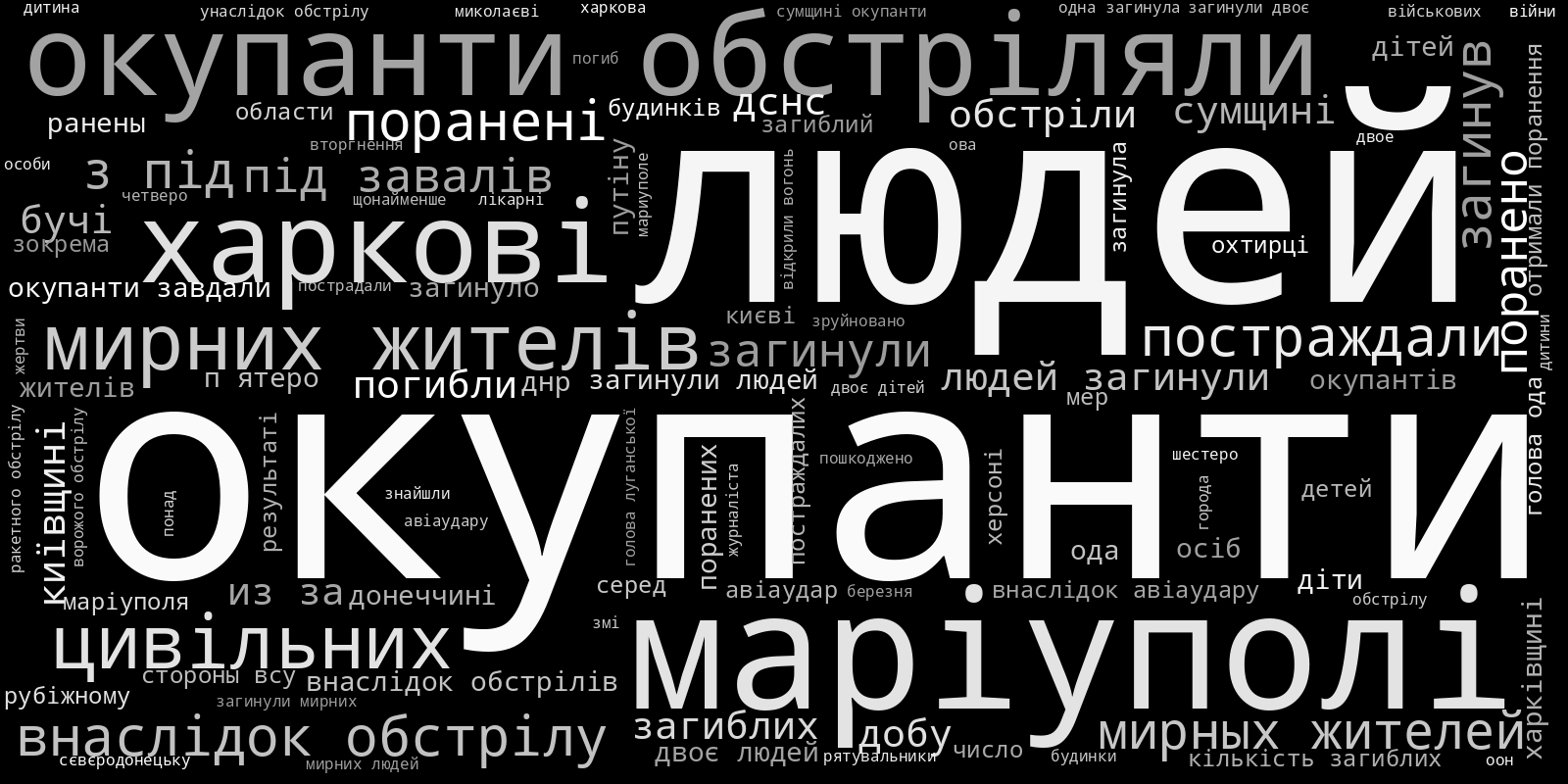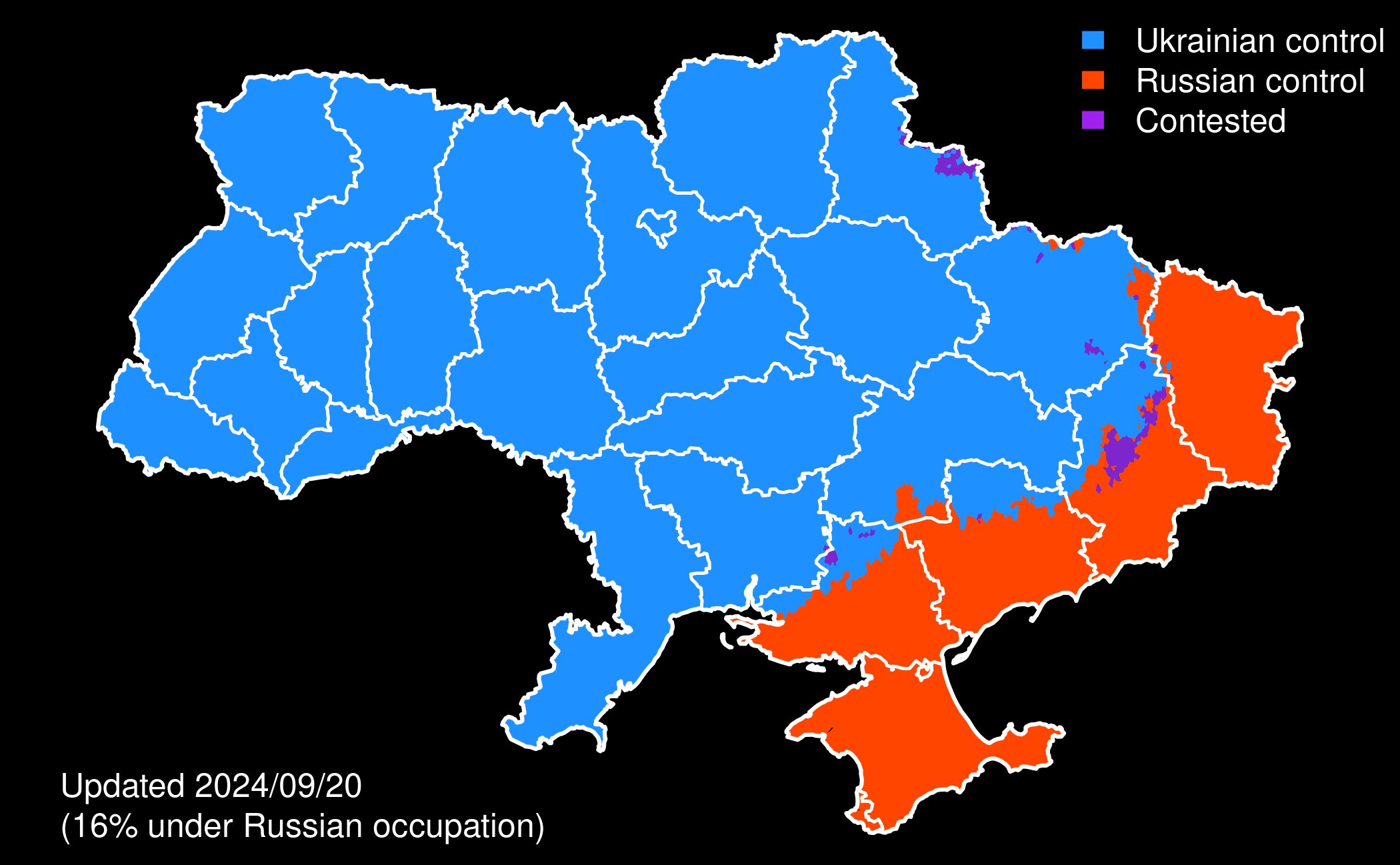VIINA/ВІЙНА/ВОЙНА/WAR 2.0 is a near-real time multi-source event data system for the 2022 Russian Invasion of Ukraine. These data are based on news reports from Ukrainian and Russian media, which were geocoded and classified into standard conflict event categories through machine learning. In addition to raw events, VIINA also includes data on territorial control, at the level of individual populated places.
These data are GIS-ready, with temporal precision down to the minute. Each observation is accompanied by full source information, text and URLs.
VIINA is updated daily, and is freely available for use by students, journalists, policymakers, and everyday researchers.
The most recent versions these data are available as a comma-delimited-text (csv) files within the following compressed ZIP archives:
- Data/control_latest.zip | Territorial control status
- Data/event_info_latest_2022.zip | Raw event reports for 2022 (locations, dates, urls, headlines)
- Data/event_info_latest_2023.zip | Raw event reports for 2023 (locations, dates, urls, headlines)
- Data/event_info_latest_2024.zip | Raw event reports for 2024 (locations, dates, urls, headlines)
- Data/event_labels_latest_2022.zip | Event reports for 2022, labeled by actor and tactic (from BERT model)
- Data/event_labels_latest_2023.zip | Event reports for 2023, labeled by actor and tactic (from BERT model)
- Data/event_labels_latest_2024.zip | Event reports for 2024, labeled by actor and tactic (from BERT model)
- Data/event_1pd_latest_2022.zip | De-duplicated event reports and labels for 2022 ("one-per-day" filter)
- Data/event_1pd_latest_2023.zip | De-duplicated event reports and labels for 2023 ("one-per-day" filter)
- Data/event_1pd_latest_2024.zip | De-duplicated event reports and labels for 2024 ("one-per-day" filter)
Note that each event data release includes both raw event reports (event_info, event_labels) and a simplified, de-duplicated data file (event_1pd). The latter uses a "one-per-day" filter to remove potential duplicate event reports, by treating multiple event reports of the same type (i.e. same combination of actor and tactic labels) in the same populated place on the same day as a single unique event.
Previous data versions are available by request (email me).
Also included are tessellated geometries of Ukrainian populated places (N = 33,141), which were used to create some of the maps on this site. These can be matched to the territorial control data by the variable geonameid:
For additional information on VIINA (1.0) and illustrative analyses, see:
- Zhukov, Yuri (2023). "Near-Real Time Analysis of War and Economic Activity during Russia’s Invasion of Ukraine." Journal of Comparative Economics 51 (4): 1232-1243 (doi.org/10.1016/j.jce.2023.06.003). Offprint available here.
Please cite VIINA 2.0 data as:
- Zhukov, Yuri and Natalie Ayers (2023). "VIINA 2.0: Violent Incident Information from News Articles on the 2022 Russian Invasion of Ukraine." Cambridge, MA: Harvard University. (https://github.com/zhukovyuri/VIINA, accessed [DATE]).
Corrections, feedback welcome:
Yuri M. Zhukov. Visiting Associate Professor of Public Policy, Harvard Kennedy School. yzhukov-at-hks-dot-harvard-dot-edu. zhukovyuri.github.io.
VIINA 2.0 draws on news reports from the following Ukrainian and Russian news providers:
- 24 Канал ("24tvua"): Ukrainian 24 hour news network
- Espreso TV ("espreso"): Ukrainian Internet TV station
- Forbes Ukraine ("forbesua"): Ukrainian edition of Forbes magazine
- Інтерфакс-Україна ("interfaxua"): Ukrainian affiliate of Russia's Interfax news wire service
- Комсомольская Правда ("kp"): Russian newspaper
- ЛІГА.net ("liga"): Ukrainian internet news service
- Live Universal Awareness Map ("liveuamap"): Ukrainian conflict event mapping service
- Мілітарний ("militarnyy"): Ukrainian defense news portal
- Медиазона ("mz"): Russian news portal
- Медуза ("meduza"): Russian news portal
- НВ ("nv"): Ukrainian magazine and internet news portal
- Независимая Газета ("ng"): Russian newspaper
- НТВ ("ntv"): Russian television news
- Українська правда ("pravdaua"): Ukrainian newspaper
- РИА Новости ("ria"): Russian news wire service
- УНІАН ("unian"): Ukrainian news wire service
This set of sources may expand/change as the war unfolds -- due to interruptions to journalistic activity from military operations, cyber attacks, and state censorship, as well as the availability of new data from other information providers.
Using an automated web scraping routine (which runs every 6 hours), VIINA extracts the text of news reports published by each source and their associated metadata (publication time and date, web urls). Using natural language processing, the system extracts and geocodes location names mentioned in each news item. A neural network model then classifies each event report into several pre-defined categories.
Events were geo-located by place names mentioned in the text of each news report, using APIs from Yandex and OpenStreetMaps. All unique geocoded locations were manually inspected for false positive and false negative matches.
Geocoding precision ranges from street-level (GEO_PRECISION="STREET") to province-level (GEO_PRECISION="ADM1").
Below is a map of all geocoded event reports since the start of Russia's military operations on February 24, 2022. Underneath the map is a timeline, showing the number of event reports published per day, across all data sources.
Here is the subset of events under the category of "military operations" (t_mil_b=1):
Here are the same data, after passing through a "one-per-day" filter to remove potential duplicates (event_1pd_latest.csv):
 (all event types, one-per-day filter)
(all event types, one-per-day filter)
 (reports about military operations, one-per-day filter)
(reports about military operations, one-per-day filter)
The data currently include the following event categories:
t_mil: Event is about war/military operationst_loc: Event report includes reference to specific locationt_san: Event report mentions economic sanctions imposed on Russiaa_rus: Event initiated by Russian or Russian-aligned armed forcesa_ukr: Event initiated by Ukrainian or Ukrainian-aligned armed forcesa_civ: Event initiated by civiliansa_other: Event initiated by a third party (e.g. U.S., EU, Red Cross)t_aad: Anti-air defense, Buk, shoulder-fired missiles (Igla, Strela, Stinger)t_airstrike: Air strike, strategic bombing, helicopter striket_airalert: Air raid siren/alertt_armor: Tank battle or assaultt_arrest: Arrest by security services or detention of prisoners of wart_artillery: Shelling by field artillery, howitzer, mortar, or rockets like Grad/BM-21, Uragan/BM-27, other Multiple Launch Rocket System (MRLS)t_control: Establishment/claim of territorial control over population centert_firefight: Any exchange of gunfire with handguns, semi-automatic rifles, automatic rifles, machine guns, rocket-propelled grenades (RPGs)t_ied: Improvised explosive device, roadside bomb, landmine, car bomb, explosiont_raid: Assault/attack by paratroopers or special forces, usually followed by a retreatt_occupy: Occupation of territory or buildingt_property: Destruction of property or infrastructuret_cyber: Cyber operations, including DDOS attacks, website defacementt_hospital: Attacks on hospitals and humanitarian convoyst_milcas: Event report mentions military casualtiest_civcas: Event report mentions civilian casualties
VIINA 2.0 uses a BERT-based transformer model (Devlin, et al., 2018) to classify news headlines into the above event categories. Transformers, first developed by Google in 2017, are a class of neural networks that can provide significant performance and efficiency gains over previous generations of recurrent neural networks (RNNs) and convolutional neural networks (CNNs) by using attention, which tracks relationships between elements of the data and enabling significant parallelization. One high-performing and widely-utilized transformer model is Bidirectional Encoder Representations from Transformers (BERT), developed by Google in 2018. This model uses only transformer encoder layers, whereas other models make use of both encoders and decoders, or only decoders.
We employ an iteration of the BERT-base model, pre-trained using 12 transformer layers, 110 million parameters, and 3.3 billion words. Specifically, we use KoichiYasouka's bert-base-slavic-cyrillic-upos model, an iteration of the ruBERT-base model trained on Belarusian, Bulgarian, Russian, Serbian, and Ukrainian texts for part-of-speech tasks. We fine-tune this model for classification using a labeled random subset of the Ukrainian and Russian news headlines scraped for VIINA and use the resulting fully-trained model to categorize all VIINA headlines.
The previous version of VIINA (1.0) used an RNN model with long short-term memory (LSTM) (Hochreiter and Schmidhuber, 1997). LSTMs are well-suited for learning problems related to sequential data, such as sequences of words of differential length, where the vocabulary is potentially large, and where the long-term context and dependencies between inputs are potentially informative for classification (i.e. where word order and context matters, and the bag-of-words assumption is problematic).
Below is a comparison of out-of-sample classification accuracy statistics --- areas under the Receiver-Operator Characteristic (AUC ROC) curves --- for the BERT (roc_bert) and LSTM (roc_lstm) models. These statistics can be interpreted as the probability that the model assigns a higher predicted probability to a randomly chosen event (e.g. t_mil=1) than to a randomly chosen non-event (e.g. t_mil=0). An AUC of 1 indicates perfect out-of-sample accuracy. An AUC of 0.50 indicates that a model performs no better than random classification. AUCs can be particularly useful in evaluating predictive performance for categories with high class imbalance (i.e. rare events, with a lot of 0's and very few 1's).
As the table suggests, BERT universally dominates LSTM on this metric:
| variable | support | roc_bert | roc_lstm |
|---|---|---|---|
| t_mil | 137 | 0.9510229 | 0.8985504 |
| t_loc | 105 | 0.9799434 | 0.9216439 |
| t_san | 35 | 0.8817756 | 0.4954361 |
| a_rus | 50 | 0.9491855 | 0.8020814 |
| a_ukr | 29 | 0.9323006 | 0.8054666 |
| a_civ | 3 | 0.8302658 | 0.7634628 |
| a_other | 20 | 0.8152542 | 0.6826271 |
| t_aad | 2 | 1.0000000 | 0.5346939 |
| t_airstrike | 4 | 0.9390369 | 0.5030738 |
| t_arrest | 8 | 0.9857955 | 0.5010331 |
| t_artillery | 34 | 0.9915875 | 0.9021320 |
| t_control | 5 | 0.9075975 | 0.5051335 |
| t_firefight | 3 | 0.9727335 | 0.5051125 |
| t_ied | 4 | 1.0000000 | 0.9659324 |
| t_property | 11 | 0.9293139 | 0.8571159 |
| t_raid | 1 | 0.9959267 | 0.5885947 |
| t_occupy | 1 | 1.0000000 | 0.5030550 |
| t_cyber | 11 | 1.0000000 | 0.8941599 |
| t_milcas | 9 | 0.9878077 | 0.7786980 |
| t_civcas | 13 | 0.9991970 | 0.5052192 |
| t_retreat | 1 | 0.9918534 | 0.4949084 |
| t_airalert | 5 | 0.8078029 | 0.7219713 |
As a general rule of thumb, we urge users of VIINA data to avoid variables for which the out-of-sample AUC is less than 0.80. Some additional caution is warranted here, since the randomly-selected data sample used to evaluate out-of-sample predictive accuracy has limited positive examples for some variables (e.g. t_raid and t_occupy each have only one positive instance in this table).
While VIINA 1.0 will no longer be updated, the most recent version is available in archived form here:
- Data/PreviousVersions/event_info_latest_v1.zip | Raw event reports (locations, dates, urls, headlines)
- Data/PreviousVersions/event_labels_latest_v1.zip | Event reports labeled by actor and tactic (from LSTM model)
- Data/PreviousVersions/event_1pd_latest_v1.zip | De-duplicated event reports and labels ("one-per-day" filter)
There are two versions of each variable included in the VIINA dataset:
- Predicted probability that event belongs to each category, from the BERT model: Floating point, from 0 to 1.
- Binary indicators (ending with "_b"): binary integer, coded 0 or 1.
We selected thresholds for dichotomizing the predicted probabilities by maximizing the F1 score against a pre-labeled (out-of-sample) test set. The F1 score is equivalent to the harmonic mean of precision and recall, or TP/(TP + 1/2(FP+FN)), where TP is the number of true positives, FP is false positives, and FN is false negatives. For each variable, the algorithm considers every potential cutoff ranging from 0 to 1, compares the resulting binary values to "true" labels, calculates the F1 score, and selects the cutoff that maximizes this score. These cutoffs are different for each variable, and are enumerated in the table below.
Below are detailed out-of-same prediction accuracy statistics for each variable, along with the cutoffs for dichotomizing each variable (cutoff_01).
| variable | f1-score | support | accuracy | roc-auc | thresholds |
|---|---|---|---|---|---|
| t_mil | 0.8531469 | 137 | 0.9146341 | 0.9510229 | 0.955 |
| t_loc | 0.8918919 | 105 | 0.9512195 | 0.9799434 | 0.501 |
| t_san | 0.7397260 | 35 | 0.9613821 | 0.8817756 | 0.967 |
| a_rus | 0.7346939 | 50 | 0.9471545 | 0.9491855 | 0.893 |
| a_ukr | 0.7450980 | 29 | 0.9735772 | 0.9323006 | 0.857 |
| a_civ | 0.3636364 | 3 | 0.9857724 | 0.8302658 | 0.217 |
| a_other | 0.3888889 | 20 | 0.9552846 | 0.8152542 | 0.747 |
| t_aad | 1.0000000 | 2 | 1.0000000 | 1.0000000 | 0.075 |
| t_airstrike | 0.8571429 | 4 | 0.9979675 | 0.9390369 | 0.054 |
| t_armor | 0.0000000 | 0 | 1.0000000 | NA | 0.500 |
| t_arrest | 0.6363636 | 8 | 0.9837398 | 0.9857955 | 0.025 |
| t_artillery | 0.8888889 | 34 | 0.9837398 | 0.9915875 | 0.045 |
| t_control | 0.6666667 | 5 | 0.9918699 | 0.9075975 | 0.017 |
| t_firefight | 0.5000000 | 3 | 0.9959350 | 0.9727335 | 0.589 |
| t_ied | 1.0000000 | 4 | 1.0000000 | 1.0000000 | 0.753 |
| t_property | 0.5714286 | 11 | 0.9817073 | 0.9293139 | 0.143 |
| t_raid | 0.5000000 | 1 | 0.9959350 | 0.9959267 | 0.065 |
| t_occupy | 1.0000000 | 1 | 1.0000000 | 1.0000000 | 0.059 |
| t_cyber | 1.0000000 | 11 | 1.0000000 | 1.0000000 | 0.044 |
| t_hospital | 0.0000000 | 0 | 1.0000000 | NA | 0.500 |
| t_milcas | 0.8000000 | 9 | 0.9939024 | 0.9878077 | 0.457 |
| t_civcas | 0.9600000 | 13 | 0.9979675 | 0.9991970 | 0.968 |
| t_retreat | 0.2857143 | 1 | 0.9898374 | 0.9918534 | 0.005 |
| t_airalert | 0.7500000 | 5 | 0.9959350 | 0.8078029 | 0.008 |
This table is available in csv format here:
Note that these statistics are subject to change, as new events are added to the corpus and as the training set expands.
Below are illustrative word clouds for several categories of events. The font size is proportional to word frequencies in news wire headlines predicted as being most likely to belong to each topic category (99th percentile of predicted probability). The clouds are for out-of-sample predictions on the full set of news stories in the corpus.
A quick guide to what some the words mean:
- "окупанти" (okupanty) means "occupiers" (in Ukrainian)
- "зсу" (zsu) is the acronym for Armed Forces of Ukraine (in Ukrainian)
- "окупанти" (okupanty) means "occupiers"
- "ворог" (voroh) means "enemy"
- "війска" (viyska) means "forces"
- "зсу" (zsu) is the acronym for Armed Forces of Ukraine (in Ukrainian)
- "всу" (vsu) is the acronym for Armed Forces of Ukraine (in Russian)
- "заявили днр" (zayavili dnr) means "DNR has claimed" (in Russian)
- "санкції" (sanktsiyi) means "sanctions"
- "сша" (ssha) means USA
- there are also terms here for sanctions related to SWIFT, Visa, MasterCard
- "збили" (zbyly) means "shot down"
- "літак" (litak) means "aircraft"
- "повітряна тривога" (povitryana tryvoha) means "air raid alert"
- "затримали" (zatrymaly) means "arrested" or "detained"
- "взяли в полон" (vzyaly v polon) means "taken prisoner"
- "танки" (tanki) means "tanks"
- "окупантів" (okupantiv) means "of occupiers"
- "голова ода" (holova oda) means "head of regional administration" (such officials sometimes make announcements about territorial control)
- "місто" (misto) means "city"
- "контролем" (kontrolem) means "[under] control"
- "бої" (boyi) means "fighting" (in Ukrainian)
- "бои" (boi) means "fighting" (in Russian)
- "обстріл" (obstril) means "shelling"
- "ракети" (rakety) means "rockets"
- "заявили днр" (zayavili dnr) means "DNR has claimed" (i.e. allegations of shelling by UA forces in Donbas)
- "наступ" (nastup) means "advance/offensive"
- "діверсантів" (diversantiv) means "of saboteurs/diversionary units"
- "висадився десант" (vysadyvsya desant) means "paratroopers landed"
- "будинків" (budynkiv) means "houses"
- "з під завалів" (z pid zavaliv) means "from under the rubble"
- "хакери" (khakery) means "hackers"
- "зламали сайт" (zlamaly sayt) means "hacked the website"
- "лікарні" (likarni) means "hospitals"
- "гуманітарні коридори" (humanitarni korydory) means "humanitarian corridors"
- "працюють" (pratsyuyut') means "are working"
- "понад" (ponad) means "more than"
- "втрати" (vtraty) means "losses"
- "окупантів" (okupantiv) means "of occupiers"
- "загинули" (zahynuly) means "died"
- "поранені" (poraneni) means "wounded"
- "людей" (lyudey) means "people"
- "дітей" (ditey) means "children"
- "цивільних" (tsyvil'nykh) means "civilian"
Raw event reports (Data/event_info_latest_2022.zip, Data/event_info_latest_2023.zip)
viina_version: Date and time of VIINA data releaseevent_id: Unique event IDevent_id_1pd: De-duplicated event ID (from one-per-day filter)date: Date of event report (YYYYMMDD)time: Time of event report (HH:MM)geonameid: Numeric ID of populated placefeature_code: Type of populated place (see full list here)asciiname: Name of populated place, ASCII valuesADM1_NAME: Name of first-level administrative unit (oblast')ADM1_CODE: Numerical code of first-level administrative unit (oblast')ADM2_NAME: Name of second-level administrative unit (rayon)ADM2_CODE: Numerical code of second-level administrative unit (rayon)longitude: Longitude coordinate of event locationlatitude: Latitude coordinate of event locationGEO_PRECISION: geographic precision of geocoded locationGEO_API: Geocoding API used to locate eventlocation: Index of unique locations mentioned in each eventaddress: Address of geocoded locationreport_id: Unique ID for report that contains the eventsource: Data source short nameurl: URL web address of event reporttext: Text of event report headline/descriptionlang: Language of report (ua is Ukrainian, ru is Russian)
Event reports labeled by actor and tactic (Data/event_labels_latest_2022.zip, Data/event_labels_latest_2023.zip):
viina_version: Date and time of VIINA data releaseevent_id: Unique event IDevent_id_1pd: De-duplicated event ID (from one-per-day filter)date: Date of event report (YYYYMMDD)time: Time of event report (HH:MM)geonameid: Numeric ID of populated placet_[event type]: Predicted probability (and binary indicator) that report describes event of each type (from BERT model, see above)a_[actor]: Predicted probability (and binary indicator) that report describes event initiated by each actor (from BERT model, see above)
De-duplicated event reports and labels (Data/event_1pd_latest_2022.zip, Data/event_1pd_latest_2023.zip):
viina_version: Date and time of VIINA data releaseevent_id_1pd: De-duplicated event ID (from one-per-day filter)date: Date of event report (YYYYMMDD)n_reports: Number of constitutive event reportsevent_ids: IDs of constitutive events (event_idin above two files)sources: Sources for constitutive events (sourcein event_info_latest files)geonameid: Numeric ID of populated placefeature_code: Type of populated place (see full list here)asciiname: Name of populated place, ASCII valuesADM1_NAME: Name of first-level administrative unit (oblast')ADM1_CODE: Numerical code of first-level administrative unit (oblast')ADM2_NAME: Name of second-level administrative unit (rayon)ADM2_CODE: Numerical code of second-level administrative unit (rayon)longitude: Longitude coordinate of event locationlatitude: Latitude coordinate of event locationGEO_PRECISION: geographic precision of geocoded locationt_[event type]: Binary indicator for each event type (from BERT model, see above)a_[actor]: Binary indicator for each actor (from BERT model, see above)
VIINA data on territorial control are based on three sources: VIINA event reports on territorial control, polygon map layers from DeepStateMap, and crowdsourced control maps from Wikipedia. In cases where the three data sources disagree, a "majority vote" rule is used to determine whether a populated place is under the control of Ukrainian forces, Russian forces, or is being actively contested between the two.
The full set of Ukrainian populated places (N = 33,141) includes all locations in the GeoNames gazetteer with feature_code's beginning in PPL*.
Each territorial control dataset includes the following fields:
geonameid: Numeric ID of populated place (can be linked to geometries in gn_UA_tess.geojson)date: Date of map update (YYYYMMDD)status_wiki: Reported control status (UA/RU/CONTESTED), from Wikipedia crowdsourced mapsstatus_boost: Reported control status (UA/RU/CONTESTED), from Wikipedia "boosted" by VIINA event reportsstatus_dsm: Reported control status (UA/RU/CONTESTED), from DeepStateMapstatus: Reported control status (UA/RU/CONTESTED), "majority vote" of wiki, boost and dsm
Note that the structure of these data have recently changed. Starting August 8, 2023, the data files have switched from a "wide" matrix format (rows are populated places, columns are status at different time points) to "long" panel data format (rows are daily observations for each populated place, columns are control status from different sources). Each daily observation uses the most recently available data from each of the three sources.






